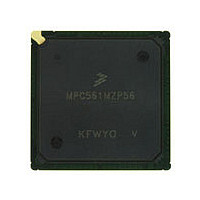MPC561MZP56 Freescale, MPC561MZP56 Datasheet - Page 806

MPC561MZP56
Manufacturer Part Number
MPC561MZP56
Description
Manufacturer
Freescale
Datasheet
1.MPC561MZP56.pdf
(1420 pages)
Specifications of MPC561MZP56
Cpu Family
MPC56x
Device Core
PowerPC
Device Core Size
32b
Frequency (max)
56MHz
Interface Type
QSPI/SCI/SPI/UART
Total Internal Ram Size
32KB
# I/os (max)
56
Number Of Timers - General Purpose
22
Operating Supply Voltage (typ)
2.6/5V
Operating Supply Voltage (max)
2.7/5.25V
Operating Supply Voltage (min)
2.5/4.75V
On-chip Adc
2(32-chx10-bit)
Instruction Set Architecture
RISC
Operating Temp Range
-40C to 125C
Operating Temperature Classification
Automotive
Mounting
Surface Mount
Pin Count
388
Package Type
BGA
Program Memory Type
ROMLess
Program Memory Size
Not Required
Lead Free Status / RoHS Status
Not Compliant
Available stocks
Company
Part Number
Manufacturer
Quantity
Price
Company:
Part Number:
MPC561MZP56
Manufacturer:
Freescale Semiconductor
Quantity:
10 000
Company:
Part Number:
MPC561MZP56R2
Manufacturer:
Freescale Semiconductor
Quantity:
10 000
- Current page: 806 of 1420
- Download datasheet (11Mb)
Modular Input/Output Subsystem (MIOS14)
It is typical to use the pulse width modulation mode of the MDASM without interrupts, although an
interrupt can be enabled to occur on the leading edge. When the output is an unchanging repetitive
waveform, the MDASM continuously generates the signal without any software intervention. When the
software needs to change the pulse width, a new trailing edge time is written to the MDASM. The output
is changed on the next full pulse. When the software needs to change the output at a regular rate, such as
an acceleration curve, the leading edge interrupt gives the software one period time to update the new
trailing edge time.
17.13.5 MIOS14 Input Pulse Accumulation
Counting the number of pulses on an input signal is another capability of the MIOS14. Pulse accumulation
uses an MMCSM. Since the counters in the counter submodules are software accessible, pulse
accumulation does not require the use of an action submodule. The pulse accumulation can operate
continuously, interrupting only on binary overflow of the 16-bit counter. When an MMCSM is used, an
interrupt can instead be created when the pulse accumulation reaches a preprogrammed value. To do that,
the two’s complement of the value is put in the modulus register and the interrupt occurs when the counter
overflows.
17-74
MIOS14 Modulus Counter Submodule
Prescaler
Modulus
Select
Control
Clock
or Pin
From
Load
Modulus Register
Figure 17-46. MIOS14 Example: Pulse Width Modulation Output
16-bit Up-Counter
MPC561/MPC563 Reference Manual, Rev. 1.2
Submodule Bus
Counter
Buses
16-bit
Two
in OCAB mode (MOD3 – MOD0 = 0b0101)
Select
Bus
MIOS14 Double Action Submodule
16-bit Register A
16-bit Register B2
16-bit Register B1
16-bit Compare A
16-bit Compare B
Freescale Semiconductor
Compare
Interrupt
Leading
Flip-Flop
Output
Output
Edge
on
Output
Pin
Related parts for MPC561MZP56
Image
Part Number
Description
Manufacturer
Datasheet
Request
R

Part Number:
Description:
MPC5 1K0 5%
Manufacturer:
TE Connectivity
Datasheet:

Part Number:
Description:
MPC5 500R 5%
Manufacturer:
TE Connectivity
Datasheet:

Part Number:
Description:
MPC5 5K0 5%
Manufacturer:
Tyco Electronics
Datasheet:

Part Number:
Description:
MPC5 5R0 5%
Manufacturer:
Tyco Electronics
Datasheet:

Part Number:
Description:
MPC5 50K 5%
Manufacturer:
Tyco Electronics
Datasheet:

Part Number:
Description:
MPC5 1R0 5%
Manufacturer:
Tyco Electronics
Datasheet:

Part Number:
Description:
TOWER ELEVATOR BOARDS HARDWARE
Manufacturer:
Freescale Semiconductor
Datasheet:

Part Number:
Description:
TOWER SERIAL I/O HARDWARE
Manufacturer:
Freescale Semiconductor
Datasheet:

Part Number:
Description:
LCD MODULE FOR TWR SYSTEM
Manufacturer:
Freescale Semiconductor
Datasheet:

Part Number:
Description:
DAUGHTER LCD WVGA I.MX51
Manufacturer:
Freescale Semiconductor
Datasheet:

Part Number:
Description:
TOWER SYSTEM BOARD MPC5125
Manufacturer:
Freescale Semiconductor
Datasheet:












